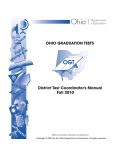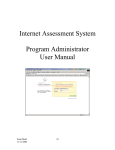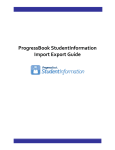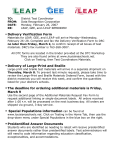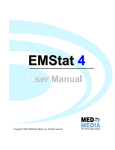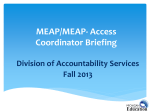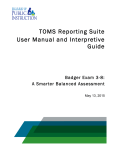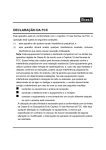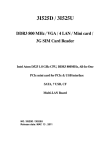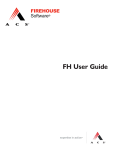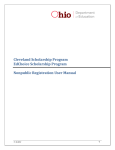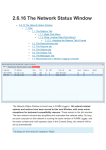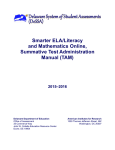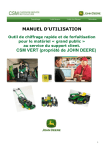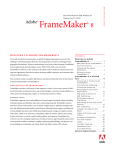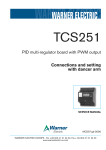Download District Test Coordinator`s Manual Summer 2010 OHIO
Transcript
hio Department of Education OHIO GRADUATION TESTS X X X X X X X X X X X X X X X XX X XX X X X X X XX X X XX . X X XX XX XX XX XX XX XX XX X XX X XX X XX XX XX X XX XX XX XX XX XX XX XX XX . XX X X XX XX XX XX XX X X X XX XX XX XX XX X XX XX XX XX XX X XX XX XX X X XX XX X XX XX XX XX XX XX XX XX XX XX XX XX XX X . XX District Test Coordinator’s Manual Summer 2010 Offices of Curriculum, Instruction and Assessment Copyright © 2010 by the Ohio Department of Education. All rights reserved. IMPORTANT Please read this manual before continuing with any other task related to the administration of the Ohio Graduation Tests (OGT). For Assistance: Ohio Department of Education (ODE) 1-877-OHIOEDU (1-877-644-6338) or 1-614-466-0223 1-614-995-5568 (Fax) Ohio Department of Education Office of Assessment 25 S. Front Street, Mail Stop 507 Columbus, OH 43215 American Institutes for Research (AIR) 1-877-231-7809 (press 2) 1-877-231-7813 (Fax) [email protected] Data Recognition Corporation (DRC) 1-877-231-7809 (press 1) 1-866-377-1249 (Fax) [email protected] Data Recognition Corporation Attn: OGT 7303 Boone Avenue Brooklyn Park, MN 55428 The Ohio Department of Education does not discriminate on the basis of race, color, national origin, sex, religion, age, or disability in employment or the provision of services. Table of Contents General Information ............................................................................................... 1 District Test Coordinator Responsibilities ...................................................... 1 Students Eligible for the Summer Administration (June 14 – June 27, 2010) .................................................................... 2 Test Schedule ................................................................................................. 2 Test Administration......................................................................................... 2 Administration Reminders ...................................................................................... 3 Tracking Answer Documents ........................................................................ 3 Calculators ..................................................................................................... 3 Do Not Score Labels ...................................................................................... 3 Ohio Graduation Tests (OGT) Administration and Special Versions Comment Forms .................................................................................... 4 TIDE (Test Information Distribution Engine) Record Change System .......... 4 Completing Answer Document Demographic Pages ................................. 5 Applying Generic Labels to Answer Documents ......................................... 6 Statewide Student Identifier .......................................................................... 7 Testing Group Numbers ................................................................................. 7 Test Security Information ........................................................................................ 9 Ethical Use of Tests ................................................................................................ 12 Scenarios Related to the Standards for the Ethical Use of Tests ............... 13 Summer 2010 Ohio Graduation Tests Administration Calendar ....................... 14 Guidelines for Test Administration Activities ....................................................... 15 Before Testing ............................................................................................... 15 During Testing .............................................................................................. 17 After Testing .................................................................................................. 18 Summary of Scorable and Nonscorable Answer Document Return Procedures............................................................................... 22 Definition of Scorable and Nonscorable Answer Documents and Summary of Return Procedures.......................................................... 23 Invalidating Test Scores ............................................................................... 24 i Table of Contents (Continued) Note Regarding Joint Vocational Schools (JVSs) ..................................... 24 Note Regarding Nonpublic and Correctional Schools ............................. 25 Procedures for Appeal (Rescore/Verification) .......................................... 25 Secure Material Resolution Form ................................................................ 27 Appendix A — Summary of Test Security Provisions from the Ohio Administrative Code ................................................................................ 28 Appendix B — Accommodations and Special Versions .................................... 30 Criteria for the Use of Accommodations .................................................... 30 Definition of a Student with Disabilities ....................................................... 30 Definition of a Student with Limited English Proficiency ............................ 30 Sign Language ............................................................................................. 31 Summary of Special Versions/Accommodations...................................... 32 Appendix C — Sample Testing Group Roster .................................................... 34 ii General Information The purpose of this manual is to outline your responsibilities as District Test Coordinator (DTC). Additionally, this manual includes specific instructions for receiving and returning secure test materials and for disposing of other test materials. Separate color-coded test booklets will be provided for each test subject. Use the OGT answer documents provided to you by DRC for each administration. Answer documents are administration-specific, so be sure to use the appropriate answer document (i.e., Summer 2010) as indicated in the upper right corner of the front cover of the answer document. Each answer document contains space for all five subjects, and each student should complete all tests in the same answer document. Do not use answer documents from prior administrations. District Test Coordinator Responsibilities The following are some of the specific responsibilities of the DTC: • Prepare BTCs for test administration prior to testing. • Receive test materials from DRC and distribute to BTCs. • Conduct a training session for BTCs. Ensure that BTCs maintain test security by using the serial numbers to account for all secure test materials before, during and after test administration until they are returned to you. • For public districts with more than one testing school, collect ALL boxes of completed answer documents from BTCs and return them promptly to DRC for scoring. • For public districts with only one testing school, ensure that all boxes of completed answer documents are promptly returned to DRC for scoring. All materials will be picked up for return to DRC at the same location where they were originally delivered. • For nonpublic, community, and joint vocational schools, ensure that BTCs promptly return all completed answer documents to DRC for scoring. • Return all test booklets, special versions and unused answer documents to DRC. • Receive and distribute test results. • Ensure that state and district test security procedures are followed at all times: before and after test completion and during the return of test materials to you and to DRC. 1 Students Eligible for the Summer Administration (June 14 – June 27, 2010) Summer testing is optional. Students, schools, and districts may elect to participate or not participate. Participating schools and districts do not have to offer all five tests. Students who have completed grade 10 or above, who are in an adult high school program, or who have completed curriculum requirements for graduation may participate if they have not passed all required tests. Students who are not classified as grade 10 or above by June 30 of the preceding school year may not participate unless they are enrolled in a Science, Technology, Engineering, Mathematics (STEM) school. Students who are enrolled in school are required to complete 10 hours of intervention for each subject area to be tested. Students who have completed curriculum requirements for graduation may test without the required 10 hours of intervention. Students in STEM schools below grade 10 are permitted to take the OGT. To accommodate STEM school students below grade 10, Box “L” of the demographic page has been updated to include a bubble entitled “STEM Below Grade 10.” This bubble should be gridded only for those students below grade 10 who are enrolled in STEM schools. Test Schedule The Summer Administration of the OGT begins on June 14 and ends on June 27. Districts should complete all testing within the 14-day window, which cannot begin before June 14 or extend past June 27. Districts that plan to test more than one subject should follow the sequence used during the Spring Administration: the reading test should be given first, followed by mathematics, writing, science, and social studies. Testing may begin on any day, and make-up tests may be given any time after the first day that the test was administered. Additional make-up days will not be granted to districts that have not completed testing by June 27. Except for students taking a make-up test, all students testing in a particular subject should be tested on the same day. (NOTE: Tests may be scheduled on Saturdays and Sundays.) Test Administration Students may not take more than one test on the same day and are allowed up to 2-1/2 hours to complete each test unless additional time is granted due to Individualized Education Program (IEP), Section 504 Plan or Limited English Proficient (LEP) accommodations. 2 Administration Reminders Tracking Answer Documents Answer documents shipped to districts and schools are tracked through a unique bar code and serial number printed on each answer document. The serial number is located on the back page of the answer document below the bar code. The bar code links the answer document to the district and school. Information on the district and school that received the document will be used to determine the number of answer documents returned. When a Pre-ID label or generic label is not affixed or when valid district and school IRNs are not gridded, the bar code on the answer document will also be used to determine the student’s district and school IRNs. Because answer documents are being tracked to the IRNs that receive them, please do not share answer documents with other districts. For instructions concerning Joint Vocational Schools (JVSs) and Career Technical Centers (CTCs), please refer to pages 24 and 25. Calculators Test your OGT Texas Instrument TI-30X IIS calculators for proper functioning before the test administration window. Additionally, OGT calculators should be provided to mathematics teachers prior to the test administration so that students will have the opportunity to become familiar with the calculator. OGT calculators must be distributed to students for the mathematics test and should be made available during the science test. The red TI-30X IIS is the only calculator that can be used during the mathematics and science tests. Prior to distributing the OGT calculators, each test administrator must clear the calculator memory by pressing the black “RESET” button on the back of the calculator or by pressing the “ON” button and the “CLEAR” button simultaneously. The display must read “MEM CLEARED.” Note: The instruction sheet that accompanies the TI-30X IIS calculator may not be used during the administration of the OGT. Do Not Score Labels In all situations for which an entire answer document should not be scored (e.g., a soiled answer document, an answer document completed in a foreign language that was transcribed), a “DO NOT SCORE” label (see illustration on next page) should be placed on top of the Pre-ID or generic label that was affixed to the answer document. If no Pre-ID or generic label was affixed to the answer document, the “DO NOT SCORE” label should be placed in the box labeled “APPLY LABEL HERE” where the Pre-ID or generic label would have been 3 applied. Do not affix the “DO NOT SCORE” label in Box “A” or anywhere else on the answer document other than the box labeled “APPLY LABEL HERE.” If you do not want a particular subject area test (e.g., science, writing) scored, do not apply a “DO NOT SCORE” label; instead you must submit an invalidation request (see page 24 for details). Return the answer document that should not be scored with your other nonscorable answer documents. Ohio Graduation Comment Forms Tests (OGT) Administration and Special Versions District Test Coordinators (DTCs) are now encouraged to submit comments and suggestions regarding the administration of the OGT by completing the OGT Comment Form, available online at www.ohiodocs.org. DTCs, Building Test Coordinators (BTCs) and teachers administering the OGT are encouraged to complete this form at the end of testing. An OGT Special Versions Comment Form is also available on the same Web site. TIDE (Test Information Distribution Engine) Record Change System Student demographic information provided in a Pre-ID file and printed on Pre-ID labels can now be edited through the TIDE Record Change System (www.ohtide.org). The TIDE Record Change System can also be used to associate students and their demographic information to the generic labels that will be affixed to student answer documents at the time of testing. The TIDE Pre-processing Record Change window is for updating Pre-ID label information and associating students to generic labels. Instructions for accessing and using the record change feature of TIDE are provided in the TIDE User Manual, which is available online at www.ohiodocs.org and also within TIDE. Use of the TIDE Record Change System is optional. There will not be a post-processing record change window for the Summer 2010 OGT. 4 Completing Answer Document Demographic Pages OGT demographic information is collected on the front and inside front covers of student answer documents. The front cover contains non-Pre-ID information, such as LEP/IEP status, accommodations, special versions, and tests taken. The inside front cover contains information that is provided on the Pre-ID label (e.g., SSID, grade, ethnicity). Important steps to follow: • Test administrators should affix a Pre-ID label in the box labeled “APPLY LABEL HERE.” Do not affix the Pre-ID label in Box “A.” • If a Pre-ID label is not available, test administrators who receive generic labels should affix a generic label in the box labeled “APPLY LABEL HERE.” Do not affix the generic label in Box “A.” The District IRN and School IRN fields (Boxes “P” and “Q”) do not need to be gridded when a generic label is used. • If generic labels are used, DTCs have the option of either (1) using the TIDE Record Change System to associate students and their demographic information to the generic labels that have been affixed to students’ answer documents OR (2) having students grid all required fields on the demographic page (page 2) of their answer documents as has been done in the past. If you choose to use the TIDE Record Change System, students only need to be instructed to grid the “STUDENT LAST NAME” and “STUDENT FIRST NAME” fields (Box “H”) on the demographic page of their answer documents (page 2). If you decide to use the TIDE Record Change System, you will need to inform your test administrators of this change in gridding instructions. The TIDE Record Change window for associating students by name and demographics to generic labels is June 7 through July 6. • If a Pre-ID label or a generic label is not available, all required fields on the demographic page including Boxes “P” and “Q” (page 2) must be completed. • If your district has agreed to administer the OGT to home-schooled students, your district IRN should be gridded in Box “P” (District IRN). Box “Q” (School IRN) should be gridded 999999. This will ensure that the scores will be kept out of your district data but will be available for you to provide to the home-schooled students. Generic labels may not be used for home-schooled students. 5 Applying Generic Labels to Answer Documents Schools will receive a set of generic labels with their test materials. Each generic label includes a bar code that identifies the district and school. Generic labels should be applied only to the answer documents of students who do not have Pre-ID labels. For a student without a Pre-ID label, apply a generic label to the answer document to indicate the district and school to which the student’s scores should be reported. When a generic label is used, DTCs can associate a student and his or her demographic information to the bar code of the generic label that was affixed to the student’s answer document by using the TIDE Record Change System. If the TIDE Record Change System is used, DTCs should instruct BTCs and test administrators to have students grid “STUDENT LAST NAME” and “STUDENT FIRST NAME” fields (Box “H”) on the demographic page (page 2) of their answer documents. DTCs are then responsible for entering the following required student demographic information into TIDE: student first and last names, SSID, date of birth, grade, gender, migrant status, and ethnicity. If DTCs choose not to use the TIDE Record Change System, students must grid all required fields on the demographic page of their answer documents: “STUDENT LAST NAME” (Box “H”), “STUDENT FIRST NAME” (also Box “H”), “SSID” (Box “I”), “DATE OF BIRTH” (Box “K”), “GRADE” (Box “L”), “GENDER” (Box “M”), and “ETHNICITY” (Box “N”). If the TIDE Record Change System is used, DTCs and BTCs must keep track of which student is associated with each generic label, identified by the bar code on the generic label, in order to associate students’ demographic information with their generic label in TIDE. DTCs may want to use a spreadsheet to track this information. Nonpublic and correctional schools may receive generic labels with the school IRN and name identified in both the District IRN and Name fields. Refer to the “Note Regarding Nonpublic and Correctional Schools” section on page 25 for more information. Generic labels are not available for home-schooled students, JVSs and CTCs. Because of the large number of home districts that can be associated with a CTC, students attending CTCs who do not have Pre-ID labels must grid their home district in the District IRN field and their attending CTC in the School IRN field (Boxes “P” and “Q”) on the demographic page. The IRN fields are located on the inside front cover. Refer to the “Note Regarding Joint Vocational Schools (JVSs)” section on pages 24 and 25. 6 Statewide Student Identifier Use of the Statewide Student Identifier (SSID) is required for all of Ohio’s statewide assessments. The SSID is embedded in the bar code on the Pre-ID labels, but it is not visible to the eye. For schools that do not use Pre-ID labels or when Pre-ID labels are not available for students being tested, test administrators will need to be prepared to grid the SSID in Box “I” on the inside front cover of each student’s answer document. Test administrators will need to acquire SSID information before administering the tests, unless SSID identifiers are not assigned to your district/school. If your district/school is in a category to which SSID identifiers are not assigned, then leave Box “I” blank. Because of the confidentiality of the SSID, districts should have a policy and/or procedure in place for schools to obtain the SSID if needed to complete Box “I” without jeopardizing secure student information. Comprehensive information about the SSID may be found online by accessing the ODE Web site at education.ohio.gov, keywords SSID and Statewide Student Identifier. Testing Group Numbers Test administrators are required to instruct students to grid Box “B” “TESTING GROUP NUMBER BASED ON LOCATION” (see illustration below) on the front cover of students’ answer documents. A testing group is defined as any location (e.g., room 105) within the school where an OGT test administration (of any size) is being conducted. The purpose of assigning a testing group number to a testing location is to aid in identifying a cohort of students quickly and easily should an anomaly occur during testing, such as defective materials being discovered after the test is administered. 7 The district must designate a person or persons to assign testing group numbers to all testing locations within each school. Test administrators must be told their testing group number for a given test location in order to instruct students on how to complete Box “B” of their answer documents. The sample Testing Group Roster in Appendix C (page 34) may be used to assign or record testing group numbers. This roster is also available for download from the ODE Web site at education.ohio.gov; keyword search Testing Group Numbers. Use of testing group numbers is required, but use of the Testing Group Roster is not. For example, schools may develop their own spreadsheet or use a local database to organize the testing group information. Regardless of the method used to assign testing group numbers, any documentation should be kept at either the school(s) or the district for one year after the test administration. You should discuss with your BTC(s) the best place to keep this documentation. You may be asked to make this information available after the test administration. The testing group number documentation should not be returned to DRC or to ODE unless requested. 8 Test Security Information All test security procedures previously established for the OGT will apply to the Summer 2010 OGT Administration. Refer to the Ohio Statewide Testing Program Rules Book for additional information on test security and procedures related to test incidents and irregularities. Maintaining test security is one of your most important responsibilities as a DTC. Your district’s written procedures for protecting the security of test materials should be followed at all times. Secure test materials consist of test booklets (including large print and Braille), language translation scripts, scorable and nonscorable answer documents, and other materials that contain student information or responses, e.g., Mathematics Reference Sheets with student writing. It is illegal and unethical to reproduce or disclose any secure material or to cause it to be reproduced or disclosed in any format. Each test contains questions and other material that will be used on future forms of the test. Therefore, security is vital for future administrations as well as the current administration. You are responsible for ensuring the security not only of the physical test booklets but also of the content of those booklets. Your responsibility for maintaining the security of test questions and materials does not end when materials are returned. You should be aware that, under Ohio law, releasing any test question or other content of a test to students or assisting students to cheat in any way may result in invalidation of test scores, termination of employment, suspension of license to teach, and/or prosecution. A test incident must be reported to the Ohio Department of Education within 2 business days after it becomes known to the district. Investigations involving breaches in security (violating the Ohio Administrative Code) must be documented and submitted to the Ohio Department of Education within 10 days following the conclusion of the investigation. A summary of state security provisions included in Rule 3301-13-05 of the Administrative Code can be found in Appendix A of this manual. Violations of test security provisions contained in your district’s written procedures may be punishable by penalties specified by your district. If you have questions or concerns about your responsibility for test security, consult your Board-adopted policy first. As a DTC, you are responsible for the security of all testing materials while they are in your possession. You are also responsible for ensuring that the BTCs act in accordance with all security requirements while they are in possession of test materials. Additionally, you are responsible for training all BTCs in proper test administration procedures. Test materials should be kept in a locked, secure location when they are not in use. Only individuals authorized by 9 district policy should have access to these materials. Under no circumstances should students have access to testing materials prior to testing or after a testing session is completed. All test booklets and special versions of the tests for the OGT are secure documents and must be protected from loss, theft and reproduction in any medium. A unique identification number and bar code are printed on the front cover of all secure test materials and on the back of the answer documents. The serial number consists of the last eight digits of the identification number. These eight digits are located under the bar code on the right. In the sample below, the serial number is 00000001. Students will be instructed to write the serial number of each test booklet in their answer document before beginning each test. S536014 00000001 Serial Number A range sheet on top of each pack identifies the range of serial numbers in the pack. You are expected to maintain test security by using the serial numbers to account for all secure test materials before, during and after test administration until the time you return them to DRC. DRC provides a District Security Checklist for district overage and a School Security Checklist for school secure materials. The serial numbers of all secure materials sent with the original order are recorded on these checklists. Serial numbers for all additional materials orders should be added to the last page of the District or School Security Checklist. Use these checklists to document all pertinent information regarding discrepancies or missing test booklets on the Secure Material Resolution Form. DRC maintains a record of the serial numbers of all secure test materials shipped to your district. When testing has been completed, all secure test materials must be returned. DRC will use a bar code scanner to account for all secure test materials by serial number and will provide a record of missing secure test materials to you and to ODE. If any secure test material that was shipped to your district is determined to be missing, you will be required to account for it. Test booklets are shrink-wrapped in packs of 10. The morning that your district begins administering the OGT, the shrink wrap on the pack(s) of test booklets may be opened, and individual test booklets may be delivered to the rooms as needed. Any remaining test booklets in a pack should be secured. Each 10 pack contains a range sheet that shows the range of serial numbers contained in that pack. After opening the shrink wrap, the BTC will verify that all test booklet serial numbers listed on the pack range sheet have been included in the pack. Please note: Shrink-wrapped packages must not be opened prior to the first day of testing. The BTC will immediately report to you if a possible impropriety/security breach may have occurred. As the DTC, you will investigate any report made by the BTC, document testing irregularities on the Secure Material Resolution Form, and, if necessary, contact ODE. English language Mathematics Reference Sheets are inside mathematics test booklets. The reference sheet is perforated for easy removal and use. Because the reference sheets are not secure test material unless students write on them, the district may retain any unused reference sheets. The English language version of the reference sheet is also available for download from the ODE Web site at education.ohio.gov; keyword search OGT Mathematics Reference Sheet. Additionally, the English language and foreign language versions of the reference sheet are available for download online at www.ohiodocs.org. 11 Ethical Use of Tests Pursuant to the requirements of Amended Substitute House Bill 152 (July 1993), the State Board of Education has adopted Standards for the Ethical Use of Tests (see Ohio Administrative Code 3301-7-01). These Standards guide those who are engaged at any stage of the assessment process in performing their responsibilities with honesty, integrity, due care, and fairness to all. The Standards ensure the integrity of the assessment process and the reliability and validity of inferences made from the assessment results. The Standards are designed to govern assessment practices related (but not limited) to state graduation testing, standardized achievement testing, and any other grade-level or age-level assessment conducted building-wide or district-wide. The Standards are grouped according to the following stages of the assessment process: (1) standards associated with communicating the ethical standards to and monitoring the educational practices of staff members who are assigned assessment responsibilities, (2) standards associated with practices in preparing students for an assessment, (3) standards associated with administration and scoring of assessments, and (4) standards associated with the interpretation and/or use of assessment results. Examples of ethical and unethical or inappropriate assessment practices are provided in the Standards for the Ethical Use of Tests. These examples provide a guide for identifying general categories of unethical practices that can occur at each stage of the assessment process and can be helpful during staff in-services related to assessment. Some of these examples can be found on the following page. These examples are not intended to be an exhaustive list of all possible unethical practices. Good professional judgment must be used when you are determining whether an assessment practice not listed in the standards may be unethical. If you have any questions, please contact the Ohio Department of Education. 12 Scenarios Related to the Standards for the Ethical Use of Tests Is this activity or behavior an ethical practice? Yes Using the state-provided practice tests as the sole method of preparing students for the tests without teaching the benchmarks measured by the tests. Using the state-provided practice tests as an activity after students have received instruction on the benchmarks and item formats. X X Making a copy of the graduation tests and/or preparing a student study guide based on the tests. Preparing students for the graduation tests by incorporating the graduation benchmarks in the appropriate subject curriculum. No X X Copying the vocabulary words from a secure published test that will be administered and incorporating them into language arts instruction. X Changing answers that students have written or gridded in. X Using the results of the graduation tests as one of the sources of information on which to evaluate the effectiveness of curriculum. X Hinting to a student to reconsider any answers given on a test. X Encouraging students who are not reading at grade level to stay home during the reading portion of a standardized achievement test and/or coding these lower-performing students out of the district summaries so as to exclude their scores from being reported to the public. X Correcting student responses so as to ensure a student a place in a gifted program. X Setting a testing schedule that limits students from receiving the maximum time allowed for the test. X Providing teachers and counselors with information they need to interpret test results. Revealing the test scores of one student to another student. 13 X X Summer 2010 Ohio Graduation Tests Administration Calendar As DTC, you must administer and monitor the following schedule. June 7 DRC delivers test materials to DTCs. June 7 – July 6 TIDE Pre-processing Record Change window open. June 8 DTCs distribute test materials to buildings. June 14 – June 27 Summer Test Administration June 14 – July 6 TIDE Invalidation window open. Week of June 14 DRC delivers Pre-ID labels to districts. June 15 – June 27 BTCs prepare scorable answer documents for return to the DTC or for shipment to DRC. June 15 – July 2 Districts return scorable answer documents via UPS. There is no automatic pick-up of materials for the summer administration. Districts will need to arrange for pick-up. Refer to the section “Returning Scorable Answer Documents” on pages 19 and 20. June 16 – July 2 BTCs separate all remaining scorable answer documents (make-up tests) from the secure test materials and nonscorable answer documents and return them to the DTC. June 16 – July 6 DTCs organize and return all remaining scorable answer documents (make-up tests), as well as secure test materials and nonscorable answer documents to DRC. June 29 In order to be included in the downloadable test results posted on August 2, answer documents must be shipped to DRC by June 29. August 2 Downloadable test results are available online for ALL students whose answer documents were shipped to DRC by June 29. August 2 – September 23 TIDE Rescores and Verification window open. August 24 American Institutes for Research (AIR) delivers printed score reports to districts. Interactive data available online. 14 Guidelines for Test Administration Activities The items listed below should be considered when the OGT is scheduled and administered: • No student may take more than one test per day. • No student may take the same subject-area test more than once during an administration. • Students are allowed up to 2-1/2 hours to complete each test. Districts should be sure to schedule a full 2-1/2 hours of testing. If unforeseen circumstances shorten the 2-1/2 hour testing window, students must be allowed additional time not to exceed the full 2-1/2 hour testing window. The testing must continue on the same day, ensuring that testing materials are secured and students have not had an opportunity to discuss the test with others. If security has been breached, please contact the Ohio Department of Education Office of Assessment at 614-466-0223. • If a school district chooses to test a home-schooled student, the district’s IRN should be gridded in Box “P” of the answer document and the number 999999 should be gridded in Box “Q.” • Limited English Proficient (LEP) students may use a dictionary and be permitted additional time (up to one full school day) to complete each test. Only students identified as LEP through a formal assessment (not OTELA) may have accommodations on the OGT. If a student with disabilities takes a state graduation test, the test should be administered entirely under normal testing conditions with the exception of those accommodations specifically documented in the student’s IEP or Section 504 Plan. Any accommodation must be specified before the student takes the test. Accommodations should always be related to the student’s specific disability, consistent with daily instruction and practice, and should never invalidate the inferences one may draw from the student’s performance. A student should never be allowed to take an operational state graduation test for practice. Before Testing T Conduct a training session for BTCs. Remind them to read every page of the Building Test Coordinator’s Manual immediately. T Reserve a locked, secure area for receipt and storage of test materials. 15 Receipt of Test Materials Districts will use UPS for receiving and returning materials. Test materials will arrive at the district in boxes labeled with the DTC’s name and shipping address. Each box label references the school name and is sequentially numbered. When test materials arrive, open the white district box. It contains the School Box Range Sheet, District Packing List, copies of the School Packing List(s), the District Security Checklist, and other administrative material. This box may also contain secure test materials. Please refer to your packing list. Find the School Box Range Sheet. It shows the number of boxes packaged for each school, as well as the number of boxes packaged for the district. Use this sheet to sort the boxes by building and verify that you have received all of your boxes. If you have not received all of the boxes indicated, please call the OGT Help Desk at 1-877-231-7809 and press “1.” DRC has packaged test materials for each building and has supplied you with materials based on the enrollment/material orders you submitted. (Note that answer documents are linked to a specific district and should not be shared with other districts.) Distribute materials to the BTCs as early as possible to allow for timely replacement of damaged or missing items. Remind them to save the boxes the test materials came in and to use them for returning test materials after the test administration. Remind the BTCs that they are to return test materials to you in serialnumber order; their compliance will make this process much less time-consuming for you. Find your Return Kit. It is in a white Tyvek envelope that can be found in the white district box. The kit contains a Secure Material Resolution Form, a Scorable Answer Documents Transmittal Form, a Nonscorable Answer Documents and Other Secure Materials Transmittal Form, WHITE UPS-RS labels, and SALMON DRC Return Box labels for returning nonscorable answer documents and secure materials. If the answer documents are returned to DRC from a school, please provide the necessary information to the BTC. Please note that each school will receive a Return Kit containing BLUE Return Box labels for returning scorable answer documents. 16 During Testing T Keep unused materials in locked, secure storage until all testing is completed. Unauthorized persons may NOT have access to the test materials. T Use the procedures described in the Ohio Statewide Testing Program Rules Book to document any testing incidents or irregularities reported to you by your BTC(s) before, during or after test administration. T You may make comments on any aspect of the testing process using the online OGT Comment Form at www.ohiodocs.org. T Monitor test administration procedures in each building. T NOTE: Students must use a No. 2 pencil to complete all sections of the answer document. Students may NOT use mechanical pencils or pens. Procedures to Follow for Emergency Closing of Schools During Testing In the event that a school or district is closed due to weather or another emergency during regular testing, follow these procedures. 1. Fax ODE at 1-614-995-5568 with the date(s) and reason the building/ district was closed. You do not need to call. 2. Upon return to school, continue administering the test(s) according to the schedule prescribed by ODE. Tests missed during the regular administration should be administered on the first day(s) of make-up testing. Students Who Become Sick If a student becomes ill and is unable to continue testing on the scheduled test day, the test administrator should collect the student’s test materials and note how much of the 2-1/2 hours has elapsed. The student should then complete the test on another day during the make-up test administration period, if possible, using the remaining time, not to exceed a total testing time of 2-1/2 hours. Tests that are not completed may be invalidated at the district’s discretion (see page 24 for details). Responses in a “soiled” answer document should be transcribed into a new answer document. Return the scorable answer document to DRC with other scorable answer documents. Place a “DO NOT SCORE” label over the Pre-ID or generic label that was affixed to the soiled answer document and put the answer document in a separate plastic bag. If no Pre-ID or generic label was used, place the “DO NOT SCORE” label in the space where a Pre-ID or generic label would have been affixed and put the answer document in a separate plastic bag. Return the plastic bag to DRC with your nonscorable materials. 17 After Testing T In order for their tests to be scored, students who take the test with procedural accommodations or use a Braille or large-print test booklet must have their responses transcribed verbatim into a scorable OGT answer document provided by DRC. Students who use a language translator to respond in a language other than English must have their responses translated into English for scoring. Answer documents that have been translated into English can be returned with all other scorable answer documents. Apply a “DO NOT SCORE” label to the original answer document with responses in a language other than English, and place it in a plastic bag labeled “DO NOT SCORE.” Return the plastic bag with your nonscorable materials. T Work with all BTCs to ensure that scorable answer documents are undamaged and returned promptly. If you are from a public district with more than one testing school, scorable answer documents should be packaged by your BTCs and returned to you via intra-district courier/transportation no later than June 27, 2010. You are responsible for collecting and shipping the scorable answer documents to DRC for scoring. NOTE: Materials that are returned to the districts from the buildings do not need to be opened and/or repackaged. Nonpublic schools, community schools and joint vocational schools, as well as those schools that were the only ones to test within their district, are responsible for returning scorable answer documents directly to DRC. BTCs who are returning materials directly to DRC should follow the instructions for preparing the return of scorable answer documents below. T All nonscorable answer documents should be returned with other secure materials. They may not be used for any future administrations. T When packaging materials for shipment, please observe the following guidelines: Use filler (e.g., crumpled paper or bubble wrap) to make sure secure test materials do not shift during transport. Tape boxes securely using heavy-duty shipping tape. It is recommended that you use at least three strips of tape across both the top and the bottom of the box to ensure the security of the contents during shipping. Please make sure that the box flaps with the old labels are folded down first and the blank box flaps are on top. 18 Returning Scorable Answer Documents 1. Ship scorable answer documents for all students together. The students’ answer documents will be processed at the same time, and downloadable test score results for all students whose answer documents are returned to DRC by June 29 will be available online on August 2. 2. Make sure that a BLUE DRC return box label is affixed to flap A on the top of each box containing scorable answer documents. (See sample below.) Districts must use the DRC return box label in addition to the WHITE UPS-RS label. Sample DRC Return Box Label 3. Complete the Scorable Answer Documents Transmittal Form by entering the number of scorable answer documents that were returned after the first week of testing and any additional shipments, including make-up answer documents from make-up tests. Once all of your scorable answer documents have been returned, fax this completed form to DRC 19 at 1-866-377-1249. This form does not need to be returned with your scorable answer documents. UPS Return Instructions (Scorable Answer Documents) Affix a WHITE UPS Return Service (UPS-RS) label to flap B on the top of each box. Do not send any boxes via UPS without a UPS-RS label. Please keep records of your shipments to DRC by keeping the tracking number(s). The UPS-RS number is located directly above the bar code in the middle of the shipping label. It is recommended that you copy each UPS-RS label you use. These tracking numbers do not need to be provided to DRC unless requested. There will not be an automatic UPS pick-up of scorable answer documents. Please refer to the calendar on page 14 of this manual for return dates. UPS can be reached at 1-866-857-1501. Schedule a date and time for pick-up, and inform UPS that you have UPS-RS labels. Please schedule your pick-up at least one day in advance. Same-day service is not available in all areas. Tell the UPS service representative the tracking numbers printed on the UPS-RS labels. The service representative will use these numbers to bill the pick-up and return charges to DRC. If you have a daily scheduled UPS pick-up, you may send your return shipment with the rest of your packages; however, please set apart the DRC shipment for the driver. Returning Test Booklets, Special Versions and Nonscorable Answer Documents All secure test materials, including test booklets, Braille booklets, largeprint booklets, and language translation scripts, must be accounted for and returned after the completion of testing. Nonscorable answer documents must also be returned. Immediately after all testing is concluded and scorable answer documents have been shipped to DRC, collect all remaining test booklets, other secure test materials (i.e., Braille and large-print test booklets and language translation scripts) and nonscorable answer documents from the buildings. If you find a scorable answer document mixed in with the nonscorable test materials that have been returned to you, separate the answer document from the nonscorable test materials, place it in a box, affix a BLUE DRC return box label and a WHITE UPS-RS label, and call UPS for pick-up. Arrange the test booklets by subject (color code). Keep them in locked, secure storage until you have all of them ready for return. All secure test materials must be accounted for after the completion of testing. 20 Pack the nonscorable answer documents and other secure materials in the boxes in which they were delivered. For your convenience, additional flat boxes are included in the initial shipment. Affix a SALMON DRC return box label to flap A on the top of each box containing nonscorable answer documents and other secure test materials. These labels can be found in the Return Kit. Districts must use the DRC return box label in addition to the WHITE UPS-RS label. Complete the Nonscorable Answer Documents and Other Secure Materials Transmittal Form by entering the number of nonscorable answer documents and other secure materials that were returned. Fax this form to DRC at 1-866-377-1249 following the shipment of nonscorable answer documents and other secure materials. This form does not need to be returned with your shipment. Districts may NOT return nonscorable answer documents and other secure materials in the same box with scorable answer documents. Please follow all instructions above. UPS Return Instructions (Nonscorable Answer Documents and Other Secure Materials) Affix a WHITE UPS-RS label to flap B on the top of each box, making sure that it is not applied across the box flap seam. Do NOT send any boxes via UPS without a UPS-RS label. Please keep records of your shipments to DRC by keeping the tracking number(s). The UPS-RS number is located directly above the bar code in the middle of the shipping label. It is recommended that you copy each UPS-RS label being used. These tracking numbers do not need to be provided to DRC unless requested. There will not be an automatic UPS pick-up of nonscorable answer documents. Please refer to the calendar on page 14 of this manual for specific return dates. UPS can be reached at 1-866-857-1501. Schedule a date and time for pick-up and inform UPS that you have UPS-RS labels. Please schedule your pick-up at least one day in advance. Same day service is not available in all areas. Tell the UPS service representative the tracking numbers printed on the UPS-RS labels. The service representative will use these numbers to bill the pick-up and return charges to DRC. If you have a daily scheduled UPS pick-up, you may send your return shipment with the rest of your packages; however, please set apart the DRC shipment for the driver. 21 Returning the Secure Material Resolution Form Using the District Security Checklist, complete the Secure Material Resolution Form (see sample on page 27). This form can be found in the Return Kit. Fax this form to DRC at 1-866-377-1249. Discard the following materials: District Test Coordinator’s Manual and Building Test Coordinator’s Manual Administration Manuals Unused Pre-ID labels Unused generic labels If you have any questions or encounter difficulties with these shipping procedures, please call the OGT Help Desk at 1-877-231-7809 and press “1.” Summary of Scorable and Nonscorable Answer Document Return Procedures All answer documents should be separated into two groups: scorable and nonscorable answer documents. In situations for which an entire answer document should not be scored (e.g., a soiled answer document, an answer document completed in a foreign language that was transcribed), place a “DO NOT SCORE” label on top of the Pre-ID or generic label that was affixed to the answer document. If no Pre-ID or generic label was affixed to the answer document, place the “DO NOT SCORE” label in the box labeled “APPLY LABEL HERE” where the Pre-ID or generic label would have been applied. Do not affix the “DO NOT SCORE” label in Box “A” or anywhere else on the answer document other than the box labeled “APPLY LABEL HERE.” Follow the table of definitions of scorable and nonscorable answer documents on page 23 when separating answer documents. 22 Definition of Scorable and Nonscorable Answer Documents and Summary of Return Procedures SCORABLE ANSWER DOCUMENTS (See pages 19 and 20 for detailed return instructions.) Answer Document Status Return Instructions Answer documents containing student responses that should be scored. Place scorable answer documents in a box that has a BLUE return box label. Answer documents containing student responses for some subjects that should be scored and some subjects that should be invalidated. Place scorable answer documents in a box that has a BLUE return box label. (The entire answer document will be scored. See page 24 of this manual for instructions on invalidating test scores.) Blank answer documents containing no Pre-ID or generic labels or student responses. Place nonscorable answer documents and other nonscorable secure test materials in a box and affix a SALMON return box label. Answer documents containing affixed Pre-ID labels, generic labels or demographic information gridded, but no student responses. NONSCORABLE ANSWER DOCUMENTS (See pages 20 and 21 for detailed instructions.) Soiled answer documents and answer documents containing student responses that have been transcribed or translated into another answer document that should be scored; the original answer document should not be scored. All other answer documents containing student responses that should not be scored. 23 Apply a “DO NOT SCORE” label on top of the Pre-ID or generic label that was affixed to the answer document. If no Pre-ID or generic label was used, place a “DO NOT SCORE” label in the box labeled “APPLY LABEL HERE” where a Pre-ID or generic label would have been applied. Do not affix the “DO NOT SCORE” label in Box “A” or anywhere else on the answer document other than the box labeled “APPLY LABEL HERE.” Place these types of answer documents in a “DO NOT SCORE” plastic bag and place the bag(s) and other nonscorable secure test materials in a box and affix a SALMON return box label. Invalidating Test Scores BTCs should contact DTCs regarding procedures for invalidating a student’s score prior to reporting. Invalidation of a score must be done by the DTC through TIDE at www.ohtide.org. Complete instructions for accessing and using the invalidation feature of TIDE are provided in the TIDE User Guide, which is available online at www.ohiodocs.org and also within TIDE. The following information is needed to invalidate a score: • The student’s name, grade and birth date • The test area to be invalidated • The lithocode from the student’s answer document, which can be found on the bottom right front cover of the demographic page • The student’s Pre-ID or generic label bar code • The reason the test is being invalidated Possible reasons for invalidation include the following: • The student cheated. • The student did not complete the test. • The student took the same test during the same administration. • The student passed the same test during a previous administration. • Test procedures were not followed. • The student responded in the wrong section of the answer document. When a student’s test is invalidated, it will be reported as INV on the Roster of Student Performance report. NOTE: Test results cannot be invalidated through TIDE after the scores have been reported by the vendor. Any corrections to reported scores must take place at the local level through EMIS. Note Regarding Joint Vocational Schools (JVSs) To avoid delays in scoring and reporting, it is very important that you complete student answer documents correctly. Pre-ID labels for students attending JVSs/CTC schools should list the student’s attending JVS/CTC school and the student’s home district. The OGT Pre-ID file layout includes a field for the home district IRN. Home district information submitted by JVSs/CTCs during the Pre-ID window will be listed on Pre-ID labels and will be used for reporting. If the information on the Pre-ID label is 24 incorrect, do not use the Pre-ID label. Discard the label and follow the gridding instructions below and in the Administration Manual for students who do not have a Pre-ID label. If a home district uploaded the Pre-ID information for a student attending a JVS/CTC and provided only the home district and home school, the home district information will be printed on the Pre-ID label. If you choose to use the label, the student’s test results will be reported only to the home district and home school, not to the joint vocational school. For JVS students whose answer documents do not have a Pre-ID label affixed, the District IRN field (Box “P”) on the student answer document must be coded with the students’ home district IRN, and the School IRN field (Box “Q”) on the student answer document must be coded with the attending JVS/CTC school IRN. The JVS district IRN should not be used. If the fields on the student answer document are completed correctly, both the JVS and the home district will receive a copy of the students’ results. Note Regarding Nonpublic and Correctional Schools Nonpublic and correctional schools may receive Pre-ID and/or generic labels with the same school IRN and name listed for both the district and school. The known relationship between nonpublic and correctional schools and their parent entities (hierarchies) will be used to identify parent IRNs and to report students’ scores to the parent entity. Students from nonpublic and correctional schools who do not have Pre-ID labels or generic labels should grid their attending school IRN in the School IRN field (Box “Q”). The attending school IRN or the parent entity IRN may be gridded in the District IRN field; either is acceptable. Procedures for Appeal (Rescore/Verification) When a school or district has reason to believe that an error may have been made in scoring a student’s answer document and/or reporting the student’s results on one or more Ohio Graduation Tests, the school or district may request that the test(s) be rescored or verified. Requests for a rescore or verification must be made by the DTC using the TIDE online request system. The link for online requests for appeals is www.ohtide.org. There are no request forms to be mailed or faxed to the ODE Office of Assessment; all requests must be submitted through the online system. Old request forms from previous administrations will not be processed, if used and sent to ODE. 25 Rescore: A rescore is requested when a DTC wishes to have a student’s test (or tests) score reassessed. A DTC may desire a rescore if a student responded in the incorrect section of the answer document or if a student’s performance on a test (or tests) is significantly lower than would be expected, given his or her performance in the classroom or on other standardized assessments. These are just two examples of why a rescore may be requested, but there are many other reasons why a DTC may request a rescore. Verification: A verification is requested when a DNA (“did not attempt”) is reported for a test that the school or district believes the student attempted; when a student receives a score for a test the school or district believes he or she did not take; when the district believes two students’ scores were interchanged; or when a student is not listed in the report at all. There will be a $25 fee for all rescore and verification requests. Before a rescore or verification is performed, all required information must be entered into the online system, including a purchase order number. The hardcopy purchase order (no checks or money orders) should be made out to DRC and mailed or faxed to: Data Recognition Corporation Attn: OGT 13490 Bass Lake Road Maple Grove, MN 55311 1-866-377-1249 (Fax) The results of the rescore or verification cannot be appealed. At the time of a subsequent test administration, any student who has a rescore/verification request pending and/or has had a rescore/verification denied should retake the test(s) in question. If a request for a “Proficient/Not Proficient” decision is reversed and/or the student passes the test at a subsequent test administration, the student will be given credit for passing on the earliest applicable test date. 26 Secure Material Resolution Form 27 Appendix A — Summary of Test Security Provisions from the Ohio Administrative Code Rule 3301-13-05 of the Ohio Administrative Code establishes test security provisions for the graduation tests. A summary of those provisions appears below. • All test questions and all other materials are considered secure and subject to the provisions of Sections 3319.151 and 3319.99 of the Ohio Revised Code and Rule 3301-13-05 of the Ohio Administrative Code. Revised Code prohibits the disclosure of test questions, paraphrases, facsimiles, or any other material that would assist a pupil taking the Ohio Graduation Tests. • By October 1 of each year, written procedures and penalties shall be communicated to all district employees and students. • Persons designated as District and Building Test Coordinators, as well as test administrators, are responsible for ensuring that test security provisions are met. • Only authorized personnel are permitted access to secure test materials. • The district must establish written procedures to protect the security of test materials and these procedures shall include the following: ¾ Identify authorized persons to be present during testing and have access to secure material. ¾ Specify handling and tracking procedures in both the district and building. ¾ Specify procedures for investigating any alleged test security violations and penalties for confirmed violations. ¾ Specify procedures for determining whether to invalidate a student’s test score. ¾ Specify that, within 10 days of determining that a test security violation has occurred, after having first conducted an investigation, the district shall notify the Ohio Department of Education in writing of the finding of such a violation and of any action taken by the school district or participating school. ¾ Specify how written procedures will be communicated annually to employees and students in the district. • After determination that a test security violation has occurred, the District Board and/or State Board of Education may seek the maximum penalty pursuant to Section 3319.151 of the Ohio Revised Code. • Each district shall cooperate with the State Board in any investigation of a test security violation. 28 • Prior to taking action for a test security violation, the State Board shall give notice of any action and provide an opportunity for an individual to respond and present a defense. • Each Joint Vocational School administering the graduation tests shall comply with this rule. 29 Appendix B — Accommodations and Special Versions Criteria for the Use of Accommodations A student may require accommodations in test administration procedures. Accommodations must be consistent with what is regularly provided to the student for testing in the classroom. Accommodations are specified in the IEP or Section 504 Plan. If the person providing the accommodation is also administering the statewide test, then that person must be a licensed/certificated employee of the district. Accommodations should be made to facilitate participation by students with disabilities or limited English proficiency. However, any accommodation that gives a student an advantage is not considered allowable because it does not permit valid assumptions to be made from the results. Definition of a Student with Disabilities A student with a documented disability is one who has been evaluated and found to meet the eligibility criteria for enrollment in special education as defined by the Individuals with Disabilities Act (IDEA ‘04) or one who has a disability covered under Section 504 of the Rehabilitation Act of 1973. Definition of a Student with Limited English Proficiency Please refer to the Ohio Statewide Testing Program Rules Book for detailed information on the identification process for LEP students. All students identified as LEP must take the OTELA in the spring in addition to the OGT. All LEP students are allowed the use of a dictionary and may receive extended time to complete the tests. Additionally, LEP students who have been enrolled in a U.S. school for fewer than three years and are at the beginning or intermediate level in reading and writing are eligible to receive one of the following accommodations based on availability: • Read Aloud — a read-aloud administration of the tests in English. • English Audio CD — English audio recordings of the tests are available for the Fall and Spring Administrations only. • Foreign Language Audio CD — foreign language audio recordings of the tests are available for the Fall and Spring Administrations only (languages may vary by administration). 30 • Language Translation — a language interpreter who reads the tests aloud in the student’s native language and translates responses into English. ODE will reimburse for language translations during the Spring Administration only and then only for languages that are not available on CD. ODE will not reimburse for any reason during the Summer and Fall Administrations; however, a translator may be used during any administration at the school’s or district’s expense. NOTE: In order to provide an accurate measure of students’ understanding of the subject matter being assessed, passages on the reading test may not be read aloud to the students, and students’ responses on the writing test may not be translated from another language into English. Finally, LEP students who have been enrolled in U.S. schools for one year or less are exempted from taking the OGT reading and writing tests, but they must take an English language proficiency test (given locally) to measure how well they are learning English. All LEP students must continue taking the English language proficiency test until they demonstrate proficiency in English. This test may not be substituted for the OGT as a graduation requirement. Sign Language Districts that plan to administer the test in sign language should order and use the language translation materials. 31 Summary of Special Versions/Accommodations Students’ responses to the multiple-choice and constructed-response questions must all appear in the same answer document to be scored. Special For the Version/ student who Accommodation Large Print is an eligible IEP student who has difficulty reading text in a standard-size font and/or needs to highlight text. NOTE: This accommodation is made in the student’s everyday classroom instruction. Braille is an eligible IEP student who reads classroom materials in Braille. NOTE: This accommodation is made in the student’s everyday classroom instruction. Read is an eligible IEP Aloud and/or LEP student who needs a readaloud administration of the test in English. NOTE: This accommodation is made in the student’s everyday classroom instruction. Materials needed After testing Large-print test booklets (ordered through TIDE) Braille test booklets (ordered through TIDE) The test administrator will transcribe the student’s multiple-choice and constructed-response answers into a scorable answer document. The test administrator will return scorable (transcribed answer document) and nonscorable (test booklet) material to the BTC. The BTC must return the materials to the DTC; the DTC will return them to DRC. Two test booklets, one for the student and one for the test administrator (ordered through TIDE) The test administrator will collect test materials and return the scorable (completed answer document) and nonscorable (test booklet) material to the BTC. The BTC must return the materials to the DTC; the DTC will return them to DRC. 32 Special For the Version/ student who Accommodation Language is an eligible LEP Translation student who needs Script a foreign language administration of the test. Materials needed After testing Language Translation Materials (ordered through TIDE); tape recorder (supplied by school) The test administrator should verify that the translator has recorded in English the student’s responses to reading, mathematics, science, and social studies tests in one scorable answer document that includes the student’s multiple-choice and constructedresponse answers. The writing test must be written in English by the student and may not be translated. The test administrator will return the scorable answer document to the BTC. NOTE: DRC will only score answer documents that have been translated into English. Responses that are returned for scoring in a language other than English will receive no credit for these constructed responses. (Districts that suspect this occurred with one of their students will need to file an appeal. If necessary, DRC will return the answer document to the district for translation and then will rescore the answer document.) Test booklets and language translation scripts are all considered secure materials and must be returned to the BTC. A “DO NOT SCORE” label should be affixed to any answer documents that are used but are not to be scored, and the answer documents should be returned via the “DO NOT SCORE” plastic bag (see page 18 for detailed procedures). The BTC must return the materials to the DTC; the DTC will return them to DRC. 33 Appendix C — Sample Testing Group Roster 34








































